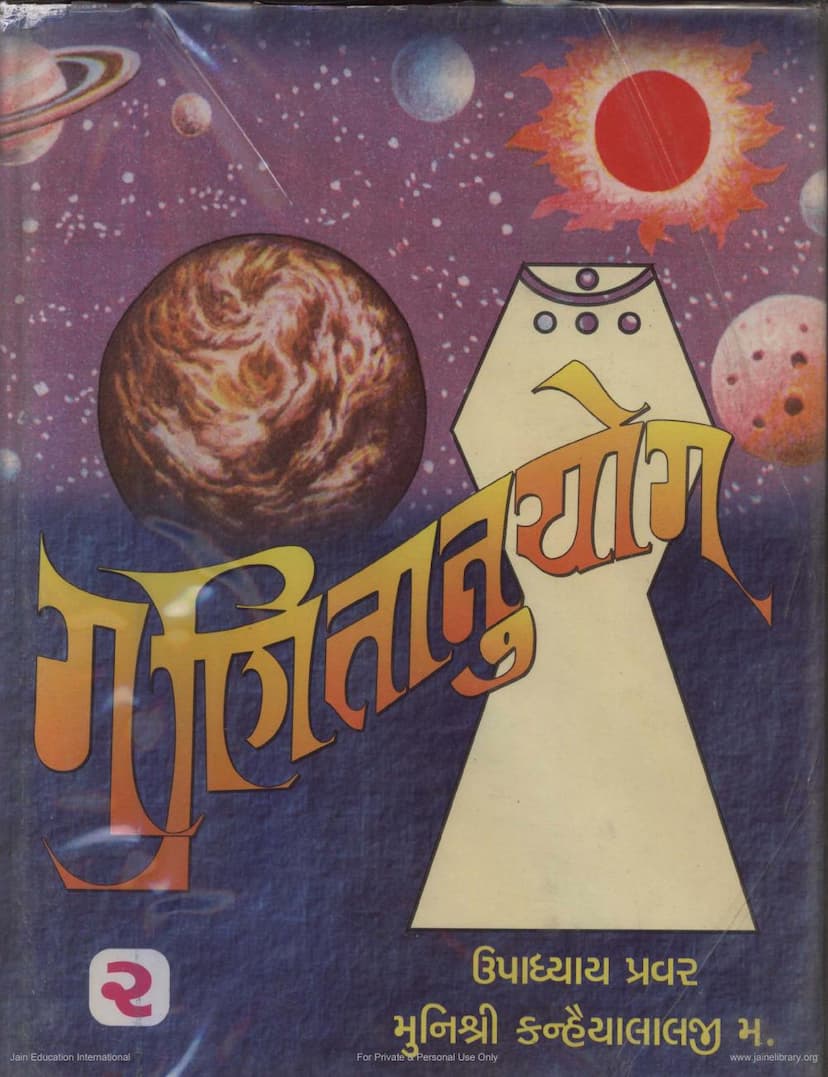Ganitanuyoga Part 2
Added to library: September 1, 2025
Loading image...

Summary
This document is the second part of "Ganitanuyoga" (mathematical and astronomical aspects of Jainism) authored by Kanhaiyalal Maharaj and published by Agam Anuyog Prakashan. It is a detailed compilation and translation of Jain scriptures concerning geography, astronomy, and cosmology.
Key aspects of the text:
- Subject Matter: The book focuses on the mathematical and astronomical content found within the Jain Agamas (sacred scriptures). It classifies and explains various concepts related to the structure of the universe (loka), celestial bodies (jyotishka), time cycles (kala), and measurements.
- Structure of the Universe (Loka): The text details the different realms within the universe, including the lower world (adhōlok), middle world (madhyalōk/tiryak lok), and upper world (ūrdhvalōk). It describes various types of celestial beings residing in these realms, such as Vanavyantara devas (intermediary beings), Jyotishka devas (celestial beings associated with stars, moon, and sun), and Vaiyānika devas (inhabitants of Vimana celestial palaces).
- Cosmography and Astronomy: A significant portion of the text is dedicated to astronomical calculations and descriptions. This includes:
- The characteristics and measurements of various Lokas (realms) like Jambu Dvipa, Lavana Samudra, Dhātakī Khanda, Kālodha Samudra, and Puṣkara Dvipa.
- The dimensions, paths, and speeds of celestial bodies like the Moon, Sun, planets, and stars, often expressed in ancient Indian units like yojanas.
- The cyclical nature of time, including the concepts of Avsarpini and Utsarpini periods (downward and upward progression of time cycles) and their subdivisions (aras).
- Detailed descriptions of the calculations involved in determining the positions and movements of celestial bodies.
- Discussions on concepts like Pauruṣī Chāyā (shadow measurement based on human proportions) and its application.
- Mathematical Concepts: The text highlights the application of mathematical principles within Jain cosmology. This includes:
- Arithmetic: Use of large numbers, place values, and potentially advanced concepts like comparability (alpbahutva) of quantities.
- Geometry: Descriptions of shapes like circles, squares, and other geometrical figures in the context of celestial bodies and their arrangements.
- Trigonometry: Indications of the use of trigonometry in calculations related to celestial movements and distances.
- The concept of 'Raju': A significant Jain cosmological unit of measurement is discussed.
- The concept of 'Ananta': Explanations of infinity in various contexts (e.g., infinite space, infinite time).
- Interdisciplinary Approach: The text bridges mathematics, astronomy, geography, and philosophy, as is common in ancient Indian scientific literature. It explains cosmological concepts through mathematical frameworks.
- Pioneering Work: The book is presented as a compilation of authentic material from Jain Agamas. It acknowledges the monumental effort undertaken by Upadhyaya Pravar Pandit Ratna Muni Shri Kanhaiyalalji 'Kamal' in classifying the entire Jain Agamas into four Anuyogas (classification of Jain literature). The book is a result of his extensive research and is dedicated to his memory.
- Translation and Editing: The Gujarati translation is provided alongside the original text, making it accessible to a wider audience. Dr. Kanubhai P. Sheth is credited as the translator. Shri Vinay Muniji 'Vageesh' served as the collator and editor.
- Sponsorship and Support: The publication is supported by various Jain community leaders and trusts, indicating the importance placed on this knowledge within the Jain tradition.
- Modern Relevance: The text implicitly suggests a connection between ancient Jain cosmological models and modern scientific understanding, encouraging further research and comparative study.
- Detailed Content: The Table of Contents at the end of the provided pages gives a glimpse into the sheer volume of detailed information covered, with hundreds of sutras addressing specific astronomical and cosmological elements.
In essence, "Ganitanuyoga Part 2" is a scholarly work that delves into the sophisticated mathematical and astronomical knowledge embedded within the Jain tradition, showcasing its ancient scientific insights into the cosmos.